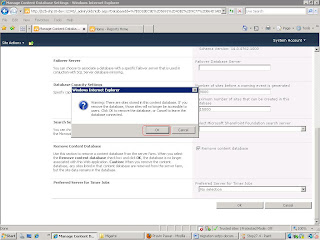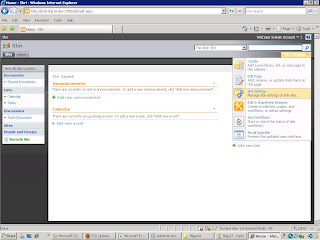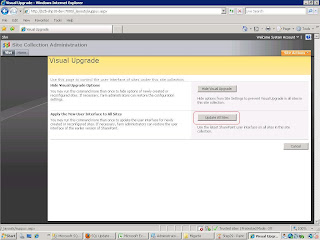SP 2010
|
MOSS 2007
|
Look and feel
| |
In SP 2010 look and feel perspective there will be a ribbon where we can have a look and feel like Office 2010
|
In MOSS 2007 there is no ribbon
|
Deployment of Web parts
| |
In SharePoint 2010 deploying custom web part is pretty simple i.e. just right click on the solution and click Deploy
|
In MOSS 2007 you need to drag the dll either to bin or GAC
|
Silverlight Application
| |
In SP 2010 we can create a Silverlight application directly from Visual Studio 2010
|
In MOSS 2007 we have to create a web part to host Silverlight application
|
Shared Database & Service Application
| |
In
SP 2010 there is no SSP but there is a concept of Service Application
like BCS as one service application, Excel Services as another
service application, User Profile as separate service application
General
idea is that you have an application for each service, rather than
one application with lots of service crammed into it
Own database rather than shared database in SP 2010
|
In MOSS 2007 we have SSP where we can work around with BI,Search Settings, User Profile Import, Excel Services, Info path
In Database also we use to have separate area for SSP stuff
|
Easy exports/imports between the forms
| |
In SP 2010 we can update existing information
|
In MOSS 2007 through we can just read the information and we can't update the existing services
|
Improvement in Deployment
| |
In SP 2010 we can Deploy through Farm based and solution based solution in SP 2010
|
In MOSS 2007 there is no such option
|
Alerts
| |
In
SP 2010 it has been improved in validation and unique values. While
creating column itself we have an option "Allow Duplicate values" to
Yes or No
|
In
MOSS 2007 alerts were sent only through emails but in SP 2010 users
can also send alerts to mobile device as SMS message. A New property
delivery channel is introduced to indicate, whether the alerts is
delivered as Email or an SMS message
|
Improvements of events
| |
New events for list creation and web creation
|
No List and web events in MOSS 207
|
Getting Items from the list
| |
In SP 2010 through object model we can fetch multiple list data by LINQ query and object model
|
In MOSS 2007 we can fetch only through object model
|
Rating
| |
In SP 2010 we can have rating column by default
|
In MOSS 2007 we should install the feature that is available in codeplex to have rating
|
Key Word Suggestions
| |
In SP 2010 we can have keyword suggestions
|
In MOSS 2007 we don’t have any keyword suggestions
|
Taxonomy
| |
In SP 2010 we can create Taxonomy by using Managed Metadata service
|
In MOSS 2007 we don’t have taxonomy
|
Other Features
| |
In SP 2010 we have Power Shell Scripting, JavaScript object model, Chart Web Parts
|
In MOSS 2007 we don’t have Power Shell Scripting, JavaScript object model, Chart Web Parts
|
Running stsadm command
| |
In SP 2010 we have to go 14 hive path to run stsadm command
|
In MOSS 2007 we have to go 12 hive path to run stsadm command
|
Wednesday, 25 April 2012
Difference between SharePoint 2010 and MOSS 2007
Saturday, 21 April 2012
MOSS 2007 web site migration In SharePoint 2010
Introduction: Number of hurdles are faced while migrating a MOSS 2007 site to SharePoint 2010 site.
They can specially cumbersome if you are SharePoint novice. In this blog I have explained the walkthrough for migrating a MOSS 2007 site to SharePoint 2010 site.
Step1: Find the content database name of your site for doing
"Central Administration ->> Application Management ->> Contents Databases".
Step2: Go
to "C:\Program Files\Microsoft SQL Server\MSSQL.1\MSSQL\Data\Your site
database name" and Copy database files .mdf and .ldf . Before you copy
these files please stop SQL services.
Or You could alternatively take contents db database backup (.bak) of MOSS2007 site using SQL Server Management Studio 2005.
Step3:
Restore your MOSS2007 content database or Attach your database files
(.mdf and .ldf) using SQL Server Management Studio 2008 r2 or create new
database and restore .bak file.
Copy your
MOSS2007 content database database files (.mdf and .ldf) in " C:\Program
Files\Microsoft SQL Server\MSSQL10_50.MSSQLSERVER\MSSQL\DATA".
Open SQL Server Management Studio 2008 r2 and Enter credential.
Right Click on "Database" and select Attach option.
New window popsup then select ADD button.
Select your mdf and ldf files and press OK.
Now Your database is attached.
Step4: Create new Web Application on Share Point 2010.
Open Central Administration.
Select Application Management. Then Select "Manage Web Application" under Web Application section.
Select New from top ribbon bar.
Enter port number, web application name and press OK.
After creation of Web Application remove the Content Database
from the new web Application. Go to "Central Administration" then Click
on "Manage Content Database"
Select your web application and then Click on Database name.
After open the content database setting page, change Database Status "Ready" to "offline".
Check "Remove Content Database" option.
After checking this option you get on popup and select "OK" then click on "OK".

Step5: Now use STSADM
to add MOSS 2007 content db to this web application. I am using the
Microsoft "Share Point 2010 Management Shell" follow following links,
Open Share Point 2010 Management Shell -Start ->> All
Programs ->> Microsoft Share Point 2010 Products
->> Share Point 2010 Management Shell.
Step6: Type command
stsadm -o addcontentdb -url http://b2b-shp10-dev:7000/ -databasename "WSS_Content_4784ff3a970149c292fe23be30d56424"
Step7:
If your old database version and new database version are same then
your database successfully attached if not then you can get following
error.
Step8:
Then go to your SQL Server management studio and Type following query
for updating version of your database.Use suggested verion by screen or
higher .
UPDATE [WSS_Content_4784ff3a970149c292fe23be30d56424].[dbo].[Versions]
SET [Version]='12.0.0.6421' WHERE[VersionId]='00000000-0000-0000-0000-000000000000'
Check version using select command
Step9: Re-executes the stsadm command.
Step10: If you get error like "Upgrade Completed with error...." then ,Redeploy all custom web parts.
Step11: Open Site in Browser.
Step12: It shows old User Interface. For new Share Point 2010 user interface follow following steps
Go to "Site Action ->> Site settings"

Select "Visual Upgrade" under the "Site Collection Administration" section
Select "Update all Sites" option

After that you can see new User Interface(UI) on your screen
Hope this information help you.
Thanks.
Subscribe to:
Comments (Atom)






















